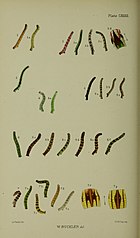Species of moth
| Eupithecia tripunctaria | |
|---|---|

| |
| Scientific classification | |
| Domain: | Eukaryota |
| Kingdom: | Animalia |
| Phylum: | Arthropoda |
| Class: | Insecta |
| Order: | Lepidoptera |
| Family: | Geometridae |
| Genus: | Eupithecia |
| Species: | E. tripunctaria |
| Binomial name | |
| Eupithecia tripunctaria Herrich-Schäffer, 1852 | |
| Synonyms | |
| |
Eupithecia tripunctaria, the white-spotted pug, is a moth of the family Geometridae. The species can be found from Europe to Korea and Japan and in North America.
Distribution
Presence extends through the Palearctic realm - (Europe, (central Scandinavia to the Alps), Russia, Russian Far East, Siberia, Amur, and Baikal to Japan and the Kuril Islands. In the Pyrenees and the Alps, E. tripunctaria occurs up to a height of 1800 m. asl. Another distribution area is located in North America, from Newfoundland to British Columbia and the San Bernardino Mountains in Southern California. The species prefers lowland forests, forest edges and damp meadows.
Morphology
The wingspan is 17–21 mm. The ground colour of the wings varies from ash grey to dark ashy brown to blackish, with the hind wings often averaging slightly paler. A pale waved line follows the margin of both wings with certain parts broken off into specific white marks which are more pronounced. These white marks give the species its name, and while they can show on both wings they are commonly absent from the hindwings. Though it is a good feature to identify this species, care should still be taken to separate it from other related species. Similar to other pug moths, a black discal spot is present on the center of the forewings, though it is often hard to see. The melanistic form f. angelicata which is a uniform smoky black, quite markingless except for the deeper black cell-spot occasionally appears in some populations. Such wholly dark forms are hard to separate from other species. The egg has an oval shape and shows hexagonal depressions in the shell sculpture.

Adult caterpillars are either greenish or brownish coloured and show very clear dark, heart-shaped, brightly framed back spots, whose tips are directed forward.The brownish pupa has dark green wing sheaths and is provided with two strong and six thin hook bristles on the cremaster.
Adults are on wing from March to September depending on the location.
The larvae feed on Apiaceae species.
References
- Yu, Dicky Sick Ki. "Eupithecia tripunctaria Herrich-Schaffer 1852". Home of Ichneumonoidea. Taxapad. Archived from the original on 24 March 2016.
- "Taxonomic Review of the Genus Eupithecia (Lepidoptera : Geometridae : Larentiinae) from Korea (II)" (PDF). Archived from the original (PDF) on 4 February 2016. Retrieved 24 January 2022.
- Eupithecia tripunctaria full description Archived 15 July 2015 at the Wayback Machine Watson, L., and Dallwitz, M.J. 2003 onwards. British insects: the genera of Lepidoptera-Geometridae. Version: 29 December 2011
- Prout, L. B. (1912–16). Geometridae. In A. Seitz (ed.) The Macrolepidoptera of the World. The Palaearctic Geometridae, 4. 479 pp. Alfred Kernen, Stuttgart.pdf
 This article incorporates text from this source, which is in the public domain.
This article incorporates text from this source, which is in the public domain.
- Vladimir Mironov: The Geometrid Moths of the World. In: Axel Hausmann (Hrsg.): The Geometrid Moths of Europe. 1. Auflage. Volume 4: Larentiinae II. Perizomini and Eupitheciini. Apollo Books, Stenstrup 2003, ISBN 87-88757-40-4
- Riley, A.M. and Prior, G. British and Irish Pug Moths A Guide to their Identification and BiologyApollo BooksISBN: 780946589517
- Wikisource:The Moths of the British Isles Second Series/Chapter 9#230
External links
| Taxon identifiers | |
|---|---|
| Eupithecia tripunctaria |
|
This Eupithecia moth related article is a stub. You can help Misplaced Pages by expanding it. |